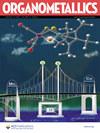Association and Aggregation of Magnesium Organocuprates
IF 2.5
3区 化学
Q2 CHEMISTRY, INORGANIC & NUCLEAR
引用次数: 0
Abstract
Despite the frequent use of magnesium organocuprates derived from Grignard reagents in organic synthesis, the molecular composition of these important reagents is poorly understood. To achieve a better understanding of their speciation in solution, we apply here a combination of electrospray-ionization mass spectrometry, gas-phase fragmentation experiments, and quantum chemical calculations. For solutions of CuCl/2RMgCl (R = Ph, 2-thienyl, Bu, and Me3SiCH2) in tetrahydrofuran, we find anions of the type [CunRn+1]−, n = 1–6. Changing the copper precursor, increasing the amount of the Grignard reagent, and adding Me2S have only relatively minor effects. Gas-phase fragmentation of the [CunRn+1]− anions results in deaggregation reactions. In addition, [CunBun+1]− and [Cu(CH2SiMe3)2]− undergo β-hydrogen and β-methyl eliminations, respectively, as well. Presumably, these decomposition pathways (as well as unknown processes) also occur in solution and explain the depletion of organyl substituents in the observed [CunRn+1]− anions. The behavior of the magnesium cuprates deviates from that of the well-studied lithium cuprates, which display a higher tendency to form heteronuclear species. Our quantum chemical calculations for LiCuPh2·LiCl and MgClCuPh2·MgCl2 in THF show that the absence of analogous heteronuclear complexes in the case of the magnesium cuprates results from higher relative Gibbs energies of these species.有机合成镁的结合与聚合
尽管有机合成中经常使用格氏试剂衍生的有机琥珀酸镁,但人们对这些重要试剂的分子组成却知之甚少。为了更好地了解它们在溶液中的标示,我们在此结合使用了电喷雾电离质谱法、气相碎片实验和量子化学计算。对于四氢呋喃中的 CuCl/2RMgCl(R = Ph、2-噻吩基、Bu 和 Me3SiCH2)溶液,我们发现阴离子的类型为 [CunRn+1]-,n = 1-6。改变铜前体、增加格氏试剂的用量和添加 Me2S 只产生相对较小的影响。CunRn+1]- 阴离子的气相破碎会导致脱胶反应。此外,[CunBun+1]- 和[Cu(CH2SiMe3)2]- 还分别发生了 β-氢和 β-甲基消除。据推测,这些分解途径(以及未知过程)也会在溶液中发生,并解释了所观察到的[CunRn+1]-阴离子中斲基取代基的消耗。镁铜酸盐的行为偏离了研究较多的锂铜酸盐,后者更倾向于形成异核物种。我们对四氢呋喃中的 LiCuPh2-LiCl 和 MgClCuPh2-MgCl2 进行的量子化学计算表明,镁铜酸盐不存在类似的异核络合物,是因为这些物质的相对吉布斯能较高。
本文章由计算机程序翻译,如有差异,请以英文原文为准。
求助全文
约1分钟内获得全文
求助全文
来源期刊

Organometallics
化学-无机化学与核化学
CiteScore
5.60
自引率
7.10%
发文量
382
审稿时长
1.7 months
期刊介绍:
Organometallics is the flagship journal of organometallic chemistry and records progress in one of the most active fields of science, bridging organic and inorganic chemistry. The journal publishes Articles, Communications, Reviews, and Tutorials (instructional overviews) that depict research on the synthesis, structure, bonding, chemical reactivity, and reaction mechanisms for a variety of applications, including catalyst design and catalytic processes; main-group, transition-metal, and lanthanide and actinide metal chemistry; synthetic aspects of polymer science and materials science; and bioorganometallic chemistry.
 求助内容:
求助内容: 应助结果提醒方式:
应助结果提醒方式:


